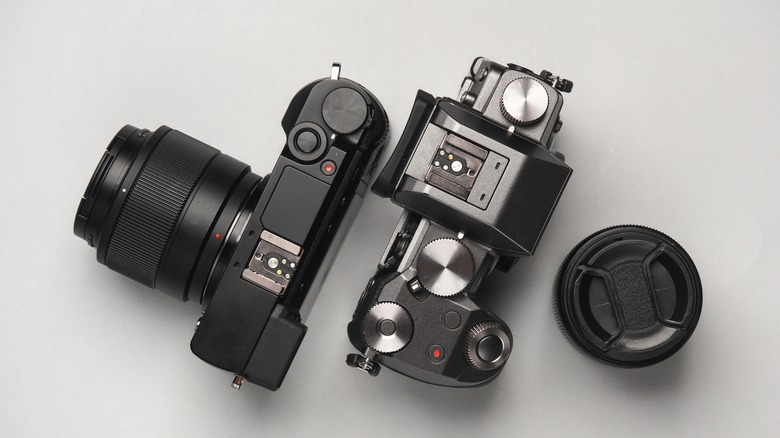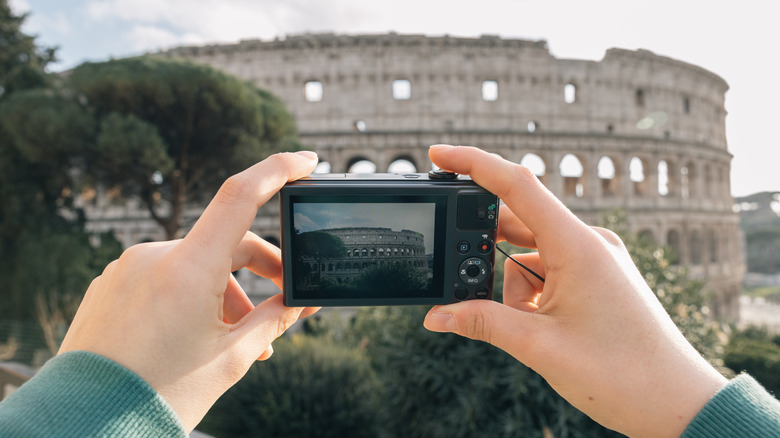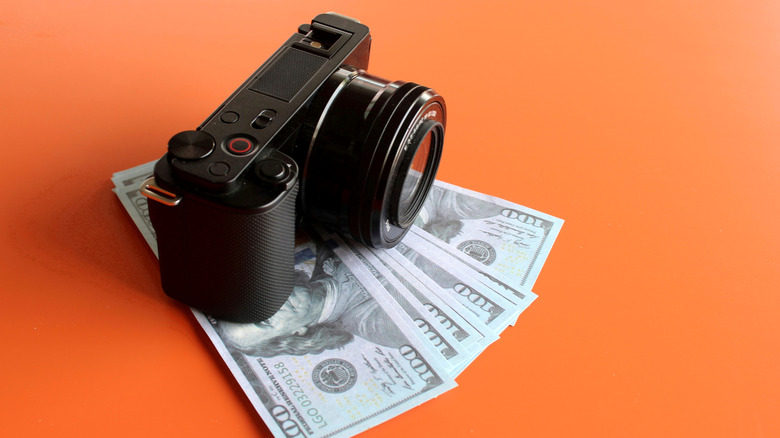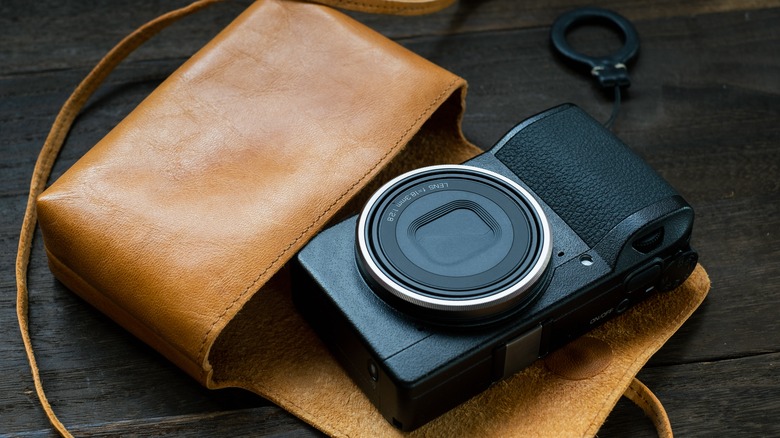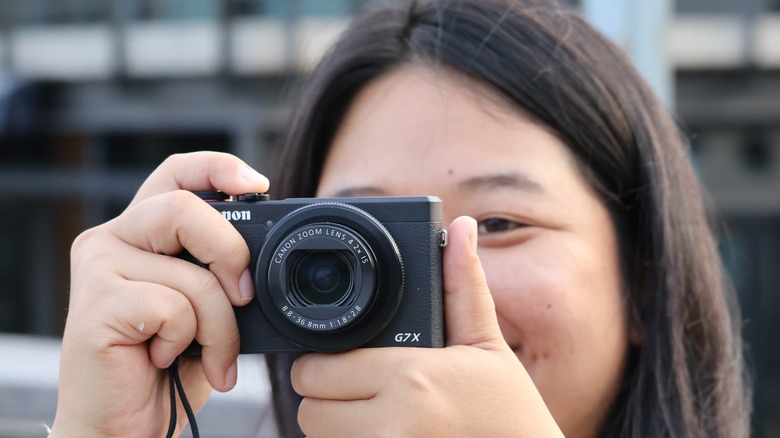Mirrorless Vs. Compact Camera: Which Camera Is Right For Your Type Of Use?
We may receive a commission on purchases made from links.
While smartphone cameras have certainly come a long way in terms of delivering beautiful photos and cinematic-quality videos, nothing can quite match the experience of using a device specifically designed to capture photos and videos. However, not all cameras are made equal, as you'll quickly find that cameras can differ wildly in terms of size, functionality, price, and more. Perhaps two of the best camera options for beginners are compact and mirrorless cameras.
If you're a beginner to the camera world, then you've likely heard these names tossed around more than a few times. Compact cameras, also commonly referred to as point-and-shoots, are primarily distinguished by their small size due to lacking the elaborate internal mirror systems of DSLRs, instead having light hit the sensor directly to capture the image. Mirrorless cameras combine many elements of both compact and DSLR cameras, coming in with way less bulk than DSLRs due to lacking a mirror system, while still giving users the ability to switch between different lenses.
With so many similarities between the two, it can seem tricky to pick between these economical camera options. Nevertheless, knowing which kind is best suited for your needs will go a long way into making your experience all the more rewarding. With over eight years of experience as a professional videographer, photographer, and multimedia editor, I have had a fair share of experience using these camera types and getting accustomed to the pros and cons of each. Based on my own knowledge and some additional research to boot, here is what to know before getting either a mirrorless or compact camera.
Image quality and functionality
Even if you aren't necessarily trying to capture National Geographic-quality pictures, how your images and videos come out is a major factor when it comes to deciding what kind of camera you purchase. In general, mirrorless and compact cameras are good quality options, but the range of features and level of control you have will vary.
The biggest feature you'll want to look into for image quality is the sensor size. As stated previously, both mirrorless and compact cameras lack the internal reflex mirror found in DSLRs, with light instead directly interacting with the sensor to create the image. Sensor sizes range from four thirds to APS-C to full frame to medium format, and cameras with larger sensors typically produce higher-quality images as they capture more light. Given their slightly larger size, mirrorless cameras tend to come equipped with larger sensors than compacts, with many even starting to adopt full frame sensors. However, even more full frame compacts are starting to pop up on the market that are even capable of shooting in 8K.
Taking each camera's versatility into account, mirrorless has a notable edge. Compact cameras are typically more capable than smartphones in terms of optical zoom and control of settings, but you're usually stuck with a single focal length and lack the ability to change out the lens or use a hot shoe to attach microphones, lights, or other accessories. Mirrorless cameras allow for maximum control of shutter speed, autofocus, white balance, and ISO while also allowing for interchangeable lens and other add-ons.
Costs
No matter what kind of camera you're looking to get, understanding your needs and investing in a device that suits them is of utmost importance. While that doesn't have to equate to dropping an entire month's worth of income, it's probably for the best that you don't go cheap. But while mirrorless and compact cameras can wildly range in price, there are some clear differences when looking at each group as a whole.
Due to the combination of their more advanced construction and compact build, you'll find that mirrorless cameras are more expensive. On the lower end, you'll find options such as the Nikon Z 30 on Amazon for a little over $600, which will only get you the camera body without any lens, SD cards, tripods, or other accessories. Prices for mirrorless cameras such as the Sony Alpha 9 III can exceed $8,000, beating even some of the highest priced full DSLR kits you'll find on Amazon.
You'll find no shortage of ultra-expensive compact cameras and kits if that's what you're really looking for, but in general you'll find that even higher end models come in at far more amiable prices. Plenty of well-reviewed and capable cameras such as the Ricoh GR III and Sony ZV-1 II can be purchased for under $1,000 and even full frame options like the LUMIX S9 go for around $1,800. Since compact cameras come with a fixed-in lens, there's little in the way of mandatory accessories you need to buy, making the upfront costs far less than that of most mirrorless cameras.
Size and portability
It's easy to ignore how much the size of your camera plays into its overall functionality and ease of use. The larger and bulkier a camera is, the more difficult it will be to handle, store away, and travel with. Smaller cameras are easier to perform many of these practical functions, but come with their own limitations in terms of performance and compatible accessories. While part of the appeal of both mirrorless and compact cameras is their smaller size compared to DSLRs, mirrorless cameras will typically be the larger of both options.
The main reason for this is their larger sensors. This, combined with their bulkier lenses and any additional equipment you choose to attach, makes for a more substantial device. While this makes mirrorless models trickier to travel with and store than a compact point-and-shoot, you'll generally find that larger cameras produce better quality images due to their additional internal mechanisms. It's worth noting that, due to lacking the reflex mirror found in DSLRs, a mirrorless camera's sensor is more susceptible to damage from sunlight, water, and dust when the lens is removed.
If traveling is a top priority, then a compact camera is by far the more viable pick. These cameras are not only slim, but often possess retractable lenses that adds to their portability. This makes even full frame compacts easier to travel with on average, often being able to fit in small bags or even pockets with ease.
Which is best for you?
As you can see, there's a lot to consider before buying a new camera of any type. I've had thoroughly rewarding experiences using both mirrorless and compact cameras in personal and professional situations, and have found it beneficial to switch between the two depending on what the job calls for. If you're going to choose one, then take the time to consider your needs and experience level first.
A compact point-and-shoot is ideal for those with simpler requirements out of their camera. If you're looking to advance your photography skills, then a compact camera is a natural step up, being more advanced and versatile than most smartphones while being far less expensive and easier to get the hang of compared to mirrorless or DSLR models. Even for more advanced photographers or videographers, having a point-and-shoot handy is still worthwhile, as their smaller size makes them more suitable for jobs that require lots of traveling or quicker set-ups.
With that said, good mirrorless cameras can prove to be a worthwhile investment. These cameras combine the best of both worlds, with the lighter build of a point-and-shoot with the versatility and power of a DSLR. They generally produce higher quality images, allow you to add on more accessories such as lenses and microphones, and give you a more diverse range of settings to expand and experiment with your style. So long as you have deep enough pockets to buy a good one and are able to keep its sensor safe from damage, then a mirrorless camera can become your new best friend.
